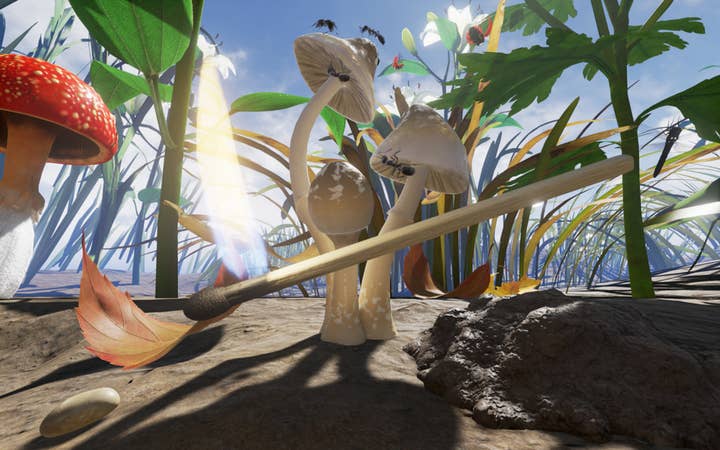Solfar's principles of virtual reality design
Development wisdom from the CCP veterans turned god makers
Solfar, the new virtual reality development studio from Thor Gunnarsson, Reynir Harðarson and Kjartan Emilsson, combines a background in AAA development at CCP with a hunger for VR innovation. Its first game, Godling, is in development for PlayStation VR and let's you play the role of a tiny toddler god, bringing chaos or joy to the world around you.
We spoke to Gunnarsson recently about the design principles that Solfar is applying to the brave new world of VR development. The first he mentions, as he fires up the headset for a demonstration, is immersion.
"You ideally want to have teams that have some background from console or high end PC development to actually create the richness of the environment"
"Immersion is this ability to create AAA quality graphics and production so you get that sort of physicality of the world around you. Whether it's hyper-real, like Godling, or something more photo-real, just getting that visual quality is so key to the overall experience.
"What we often find is less experienced teams that we're seeing demos from, they don't have enough experience with graphics optimisation. Things like shader development, lighting, and so on. Consequently they often end up with these quite basic, solid-shaded or cartoony style experiences. We think that's a bit of a challenge. You ideally want to have teams that have some background from console or high-end PC development to actually create the richness of the environment."

My experience with Godling certainly backed this up, setting off Honey I Shrunk The Kids flashbacks as I faced up to a snail the size of a cow and wandered beneath a canopy of wildflowers. The immersive quality of VR means anything that looks shoddy or basic - and nothing here does - would be far more noticeable.
"The other element is exploration. We don't believe in static worlds," he says. "They need to be worlds you can actually move through, progress through and so on. This all sounds super obvious when you're thinking about video games, but it's still a trend in the VR content space at the moment where people are shying away from it because they're afraid of motion sickness. They're afraid of shocking people.
"So we're trying to come up with this combo of first-person and third-person that we think makes a lot of sense."
The demo I tried offered two perspectives: a view from down on the ground, face to mandibles with ants and butterflies, and an overview of the world below. Swapping between the two was simple - a small fairy-type creature marked my location in the world in the overhead view - and it was easy to see how the method could help players navigate open play areas more effectively.
"The other key pillar really is agency. You have to be able to interact in the world around you, do things to the world and have it react back with you. This is of course from our experience at CCP with sandbox game design. We think this is going to be key to these sorts of worlds. Slower paced, more abstract types of player agency are pretty interesting, and that's definitely what we're trying with Godling. Just this basic idea that all of your actions should have consequences. If I want to open the door and see what's on the other side I should be able to in VR."

At this point Gunnarsson and I reminisce about adventure games set in houses where only one or two doors will open, and how this sort of development trickery works less well in virtual reality. If the world feels more real it needs to behave in a more real way too - there aren't any shortcuts.
Perhaps surprisingly, Solfar's last principle of design is one that concerns the social future of VR. The team, he says, "got religion" after seeing the Toy Box demo that Oculus created with its Touch controller.
"We've been attuned to think of virtual reality as Neal Stephenson's Snowcrash, Ready Player One, and people make this visual jump to something like Second Life, but cooler"
"It proves that human interaction, human connection within VR doesn't rely upon fully articulated, 3D avatars. It's enough to just have that abstract presence and there's something about the realtime, motion tracking kind of performance capture that you get just from the head, hands," he explains.
"We've been attuned to think of virtual reality as Neal Stephenson's Snowcrash, Ready Player One, and people make this visual jump to something like Second Life, but cooler. Then you realise there's this massive uncanny valley in between that idea and then actually executing on it. What's so cool about the Toy Box demo is that it proves that you don't need all of that."
As a result the team is already looking at ways to add "that very visceral social element" to Godling and other Solfar projects once VR has built up an install base.
"The thing with VR is, it's sort of an odd circumstance. We have this amazing platform and technology for the most immersive, distributed simulations ever, but then with one hand we give presence and immersion and with the other the platform takes away player agency.
"It takes away interaction, it reduces the interaction that we're used to having in video games for the past 20 years. So it's a real design challenge for how you actually create content that keeps that level of player agency, exploration and so on within the game."
For more on the creation of the studio check out our interview earlier this year with Emilsson and Gunnarsson.









